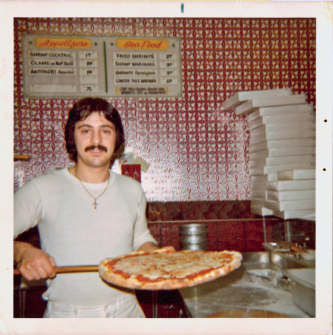
Sal’s father, Vito, making pizza
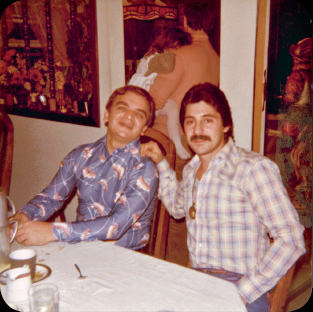
Uncle Tommy and Vito
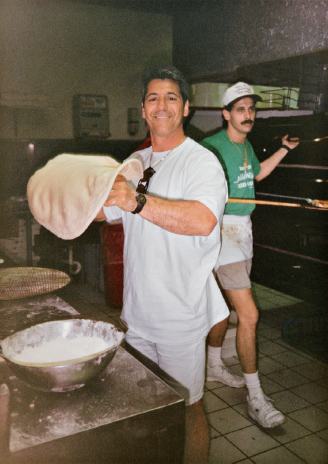
Vito, making pizza
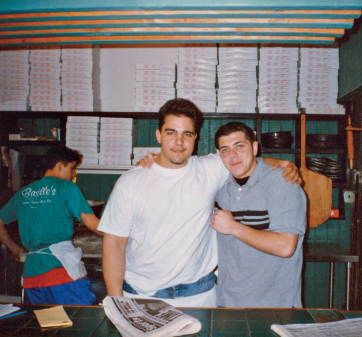
Fran’s brother Vincent with Sal
6.
Pizza is what we grew up doin’ our entire lives. It’s what put clothes on our backs. It’s what got us out of speeding tickets. It’s what made us cool in the neighborhood. It made us who we are today. It made us, period. In Staten Island, people didn’t care whose trust fund was bigger or if you were a Kardashian—if you had a good pizzeria, you were a somebody. Well, if we had to crown a King of Pizza in Staten Island, that would have to be Sal’s father, Vito. He opened the first Basille’s restaurant in 1988. Our family owned tons of pizzerias and hero shops and bakeries and other restaurants before that, but his was the biggest success, the family’s big splash. Back then, there was no Internet or Yelp or bloggers or stuff like that—it was all word of mouth. If you were good, that was street cred.
And let us tell you, Vito was good. We were the pizzeria everybody talked about. There was always a wait for tables—Friday and Saturday nights, you had to wait an hour and a half, maybe two hours just to get in. Why? Basille’s raised the bar for what you could get in a pizzeria. It wasn’t just cheese and sausage and pepperoni. We made one of the first broccoli rabe pies with garlic and red pepper flakes and olive oil. People had never seen that before! Then there was the sfinguini with anchovies, onions, bread crumbs, and sauce. And all the ingredients were good. We weren’t usin’ mushrooms outta the can; we’d be in the back, choppin’ ’em up, fryin’ ’em, seasonin’ ’em, and puttin’ ’em down on the pizzas. They were the best mushrooms you ever ate. (Check out Fast Mushrooms, here).
What also set Vito apart from the competition was that he made his dough by hand. Back then, you could buy a giant mixer with different attachments to make dough and shred cheese, but they were big money. And because most people were only chargin’ like a dollar for a slice, it wasn’t enough to buy fancy machinery. So Vito, he’d put the flour, the water, the yeast—everythin’—in a big wooden box and mix it all on his own. Do you know what a job that is? Our uncle Tommy, who worked alongside Vito for thirty years, his hands are made out of Teflon now. He’s a seventy-year-old man and can take the Yellow Pages and rip ’em in half. It’s an amazing grip this man has. He always says we could do the same thing if we were mixin’ three boxes of dough by hand a day for that many years.
The other thing Vito would do was take his balls of mozzarella and instead of shreddin’ ’em, he’d cut ’em into blocks with a dough cutter. Then he’d put the cheese down first and the sauce on top of that—the same way we do it now. No one in Staten Island was doin’ it that way then, and no one we know does it now. But think about it—you get a steamin’ hot piece outta the oven, pick it up, and what happens? The cheese slides right off. When you cook it our way—the way Vito taught us—the cheese melts into the dough. It’s a totally different product. You can take the same cheese and the same sauce and prepare it these two ways and end up with two completely different pies. The taste might be similar, but the mouthfeel and texture won’t be. So puttin’ the cheese on first and then the sauce was what made Basille’s different; it’s what gave us our edge. Everybody else was doin’ it the same way, takin’ the easy way out—just takin’ a ladle of sauce and smooshin’ it around. With our way, you gotta control the ladle, hold it like you’re holdin’ a paintbrush. Whenever we got new hires, the hardest thing to teach ’em was puttin’ on the sauce. They’d be used to hittin’ the dough with the sauce real fast and then sprinklin’ on the cheese. Now they had to be careful, do it more gingerly. The distribution of the sauce has to be perfectly even over the pie.
When we opened Artichoke, we wanted to raise the bar even higher. You could even say we went overboard, but for us, it was just makin’ pizza the way we wanted to eat it. So we started adding the best ingredients to every single pie—Parmigiano-Reggiano and olive oil and basil. In Staten Island, we couldn’t get away with that because people couldn’t afford what we’d have to charge just to break even for those ingredients. But our philosophy was, and continues to be, “Let’s make everything the best we can and charge for it.” We went after people who wanted the best. People who wanted something different and better. And if not, there’s five other pizzerias around the block they can go to instead.

MAKING NEW YORK PIZZERIA—QUALITY PIZZA AT HOME
The whole world likes pizza. But in New York City, we have a love affair with it. Italian-American pizza as we know it was born here. New York City is the “slice joint” capital of the world, but if you can’t make it out to the Big Apple, we’re gonna show you how to make it right in your own kitchen.
First, let’s talk about your oven. What gives New York–style pizza its signature crispy crust is the deck ovens that we use. Deck ovens have thick stones, which we cook the pies directly on. These stones retain a lot of heat and give our crusts that unbeatable bottom. To convert your home oven, you’re gonna need a pizza stone. Don’t have one? You can use quarry tiles. Go to Home Depot, buy a box of quarry tiles, set your oven rack all the way to the bottom, and lay your stone or quarry tile over the rack. The stone or tiles need to be heated all the way through before you put your pizza on them; otherwise, you’ll end up with a cooked top and a soggy bottom. Turn your oven up as high as it goes—we’re talking 550 to 600°F—and let it preheat for at least an hour.
Once you’ve got your oven ready, you can start preparing the dough. One of the other key ingredients to creating a real New York City pizza is making the dough with real New York City tap water. New York City tap water is by far the best-tasting tap water in the world. It’s a fact—google it. But if you’re not in New York City, don’t worry: You can use bottled Poland Spring water, which, in our opinion, is a close second when talking about great-tasting water. It’s just as soft and works wonders with dough. If you can’t get Poland Spring, go with Dasani.
To make the dough, you’ll need:
1 tablespoon instant dry yeast
2½ teaspoons salt
¼ cup olive oil, plus more for the bowl
1 cup warm water
3½ cups high-gluten flour
All-purpose flour for coating your peel and work surface
In a large bowl, combine the yeast, salt, oil, and water. (The salt is gonna give it great taste and color and the oil provides the great texture.) Add the flour and mix it in by hand until the mixture forms a ball and looks smooth. Take the dough out of the bowl, grease the bowl with a little oil, then place the dough ball back in the bowl (the oil will keep it from sticking). Cover the bowl with a dishtowel or something else that’s not airtight that will allow the dough to breathe. Set it aside for an hour at room temperature; it should double in size.
While the dough is proofing, get your sauce and toppings ready. As you’ll see in chapter 7 on sauces, New York–style pizza sauce is very simple: All there is to it is tomatoes, salt, and olive oil. And it isn’t cooked ahead of time; instead, it cooks on the pie when it goes into the oven. That’s it, plain and simple. For the full recipe, see here.
Now you’re going to need what we call a peel—a wide, flat wooden “shovel”—to get your pie into the oven. If you don’t have one, that’s okay; you can use the top of any pizza box or any other piece of cardboard that’s at least 16 by 16 inches. First, flour your peel (or your cardboard). On a floured work surface, start stretching your dough, pressing down from the outside and working your way into the middle. Try not to take all of the air out of it. Once it’s flattened, pick it up and gently toss it back and forth. Try not to let the center get thin. It’s important that the dough is even. Stretch it into a roughly 16-inch circle, then put it on the floured peel.
Now, over the top of your dough, sprinkle some cheese, spread your sauce, and add any other toppings. Carefully slide the pizza onto your pizza stone or tiles and let it cook for 12 to 15 minutes, until it looks like all the cheese has melted and started to brown. While it’s cooking, jump in your car, drive in reverse to the nearest store that sells Coca-Cola, run in, and yell, “Yo! Where’s the Coca-Cola at?” Grab your bottle, pay the guy, get in your car, and punch it home while blasting Frank Sinatra’s “New York, New York.” Take the pizza out of the oven, let it cool, get a pizza cutter, cut it up, sprinkle on the Parmigiano-Reggiano, drizzle on some olive oil, pour some Coke over ice (’cause the ice cuts the Coke), and enjoy. See that? We just saved you a trip to New York. But when you do come to New York, make sure you come to Artichoke Pizza and ask for Fran and Sal.

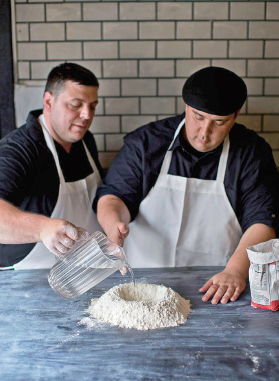
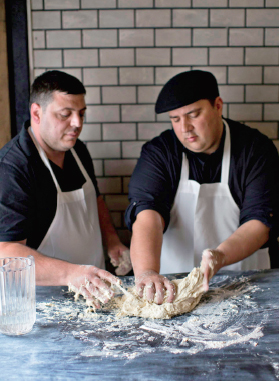
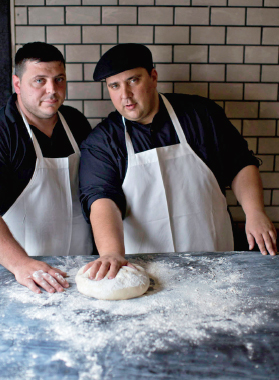
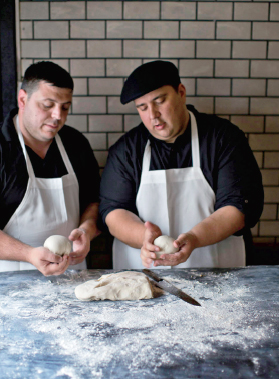
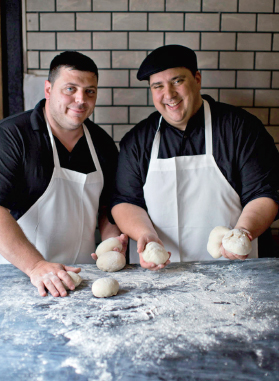
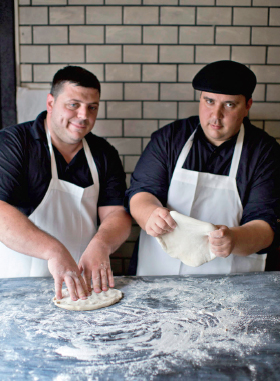
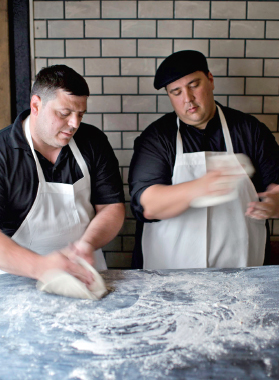
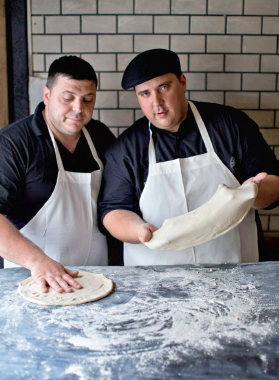
SICILIAN PIZZA
SERVES 4
Our moms made Sicilian pizza at the restaurant, but the way we wanted to make it at our place was just like our great-grandfather used to do it in his own oven. He had an apartment in Brooklyn Heights—or whateva they’re callin’ it these days—and when he made this pizza, he would always burn the life out of it. That was part of the secret—and now it’s one of our most popular slices.
The dough cooks twice—the first time, it sorta fries in all the oil you put in the pan, and it becomes a sponge for the grease. Then you add two different types of “muzzarell”: Polly-O and fresh. Polly-O is low-moisture and high-butterfat. It’s greasy—let’s just put it that way. But it’s not like a lot of other muzzarells that get like bubblegum when you cook ’em. Polly-O doesn’t do that. The cheese gets topped with our Pizza Sauce (here) and a huge handful of pecorino, then goes back in the oven, where we cook it to death. That way you get a nice slice that doesn’t fall apart, and all the flavors are really melded together. It’s not all loose and mushade.
Our first Artichoke Pizza had been open maybe two weeks when a woman came in askin’ if we were the owners. She told us that her mother had brought home a Sicilian pie the other day and that when she ate it, she started to cry. It reminded her of her grandmother, who used to make it that way in her house. You can’t get a product like that if you’re takin’ shortcuts. So maybe this recipe is a little bit of a pain in the ass—tryin’ to stretch the dough to fit the pan while it’s fightin’ ya, cookin’ it twice, all that oil splashin’ around, and all that cheese—but it makes an amazing pie.
For the Sicilian Dough:
2½ teaspoons salt
1 tablespoon dry yeast
¼ cup warm water
¼ cup olive oil, plus more for the bowl
3½ cups all-purpose flour
For the Pizza:
Olive oil
All-purpose flour, for dusting
1 recipe Pizza Sauce (here)
½ pound Polly-O whole-milk mozzarella, cut or torn into 1-inch pieces
2 ounces fresh mozzarella, cut or torn into 1-inch pieces
¼ cup grated pecorino
20 fresh basil leaves, torn in half
¼ cup grated Parmigiano-Reggiano
MAKE THE SICILIAN DOUGH:
In a large bowl, combine the salt, yeast, and water. Mix with a spoon, then add the olive oil and flour and mix until the ingredients form a ball and look smooth. Remove the dough ball from the bowl, coat the bowl with oil, and put the dough back in the bowl to proof. Cover the bowl with a dishtowel or something else that’s not airtight that will allow the dough to breathe. Set it aside for an hour. The dough should double in size.
MAKE THE PIZZA:
Preheat the oven to 500°F. Coat a 16 x 11-inch roasting pan or baking dish with 1 cup olive oil.
Turn out the dough onto a floured surface. Gently stretch it, pressing down from the outside and working your way toward the middle. Try not to take all the air out of the dough. Once it’s flattened, place it in the prepared baking dish and gently pull it to fit the shape of the dish. Take a knife and poke as many holes as you can through the dough. (If it’s an aluminum roasting pan, make sure you don’t poke any holes through the pan!)
Brush some olive oil on top of the dough and top with ¼ cup of the tomato sauce. Bake for about 5 minutes, until the dough gets golden brown on top. Remove from the oven and spread the mozzarella on top as evenly as possible. Then spread the remaining sauce to cover the mozzarella. Sprinkle the pecorino evenly over the top and return the pizza to the oven for 12 minutes more, or until the cheese is golden brown. Remove from the oven, top with the basil and Parmigiano-Reggiano, and serve hot.


